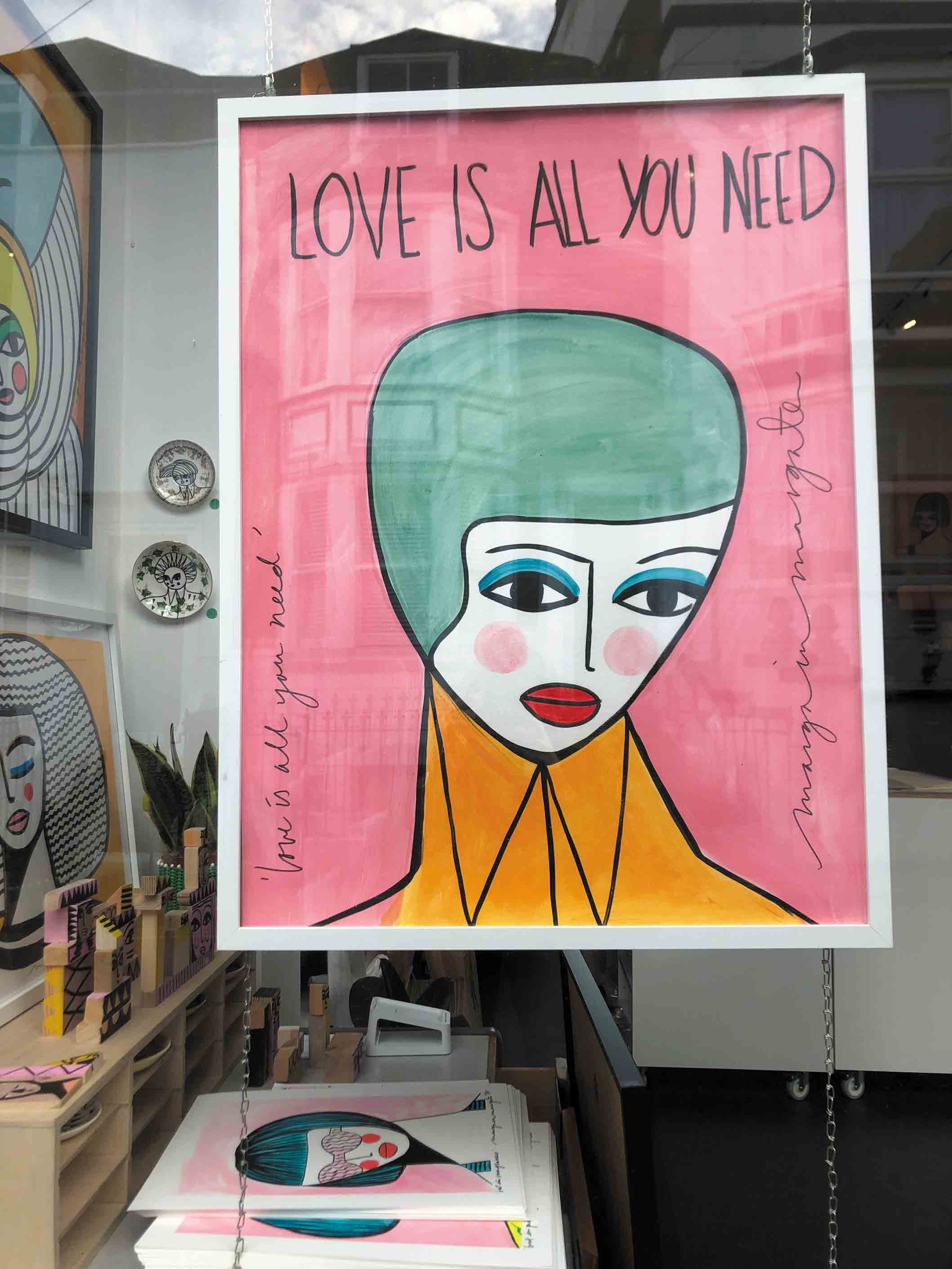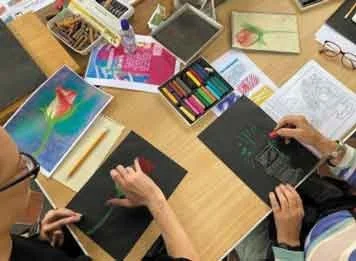DRAWN TO IT - AN INTERVIEW WITH MARGO MCDAID
Artist Margo McDaid talks to us about finding her faces, waitressing in Hell’s Kitchen and saying ‘F*ck it’
You know when you’re looking at a Margo McDaid. Etsy copycats aside, of which there are some good ones TBF, the Thanet artist’s faces of women are as distinctive as they are colourful, each character infused with a quiet confidence.
They have knowing eyes - perhaps a bi-product of the journey that has been undertaken for them to now exist on canvas in acrylic paint.
A decade ago, Margo McDaid (@MargoinMargate) challenged herself to draw a picture every day. The adventure of where it might lead was the creative carrot, while the Instagram following that was drawn to the project - entitled @MargoinMargate - was an equally rewarding root vegetable.
“It started off more like a journal of what would happen,” says Margo. “The MargoinMargate was a real accidental, sort of, really good branding kind of move, but it wasn’t intentional. Things just take a life of their own.”
Having been in Thanet for 13 years, with a shop in Ramsgate’s Addington Street and artwork for sale at the Turner Contemporary, the east coast of Kent is now home to Margo and her family. But it could have been very different.
“YOUR UNIQUE STYLE COMES FROM YOU AND COMES FROM YOUR EXPERIENCES”
Having left her parents, who weren’t exactly onboard with the idea of Margo becoming an artist, in Northern Ireland aged 19, she headed for New York and a waitressing job in Manhattan’s Hell’s Kitchen, (no, it’s nothing to do with Gordon Ramsay). It was that four-year stint in the Big Apple that geminated the seed idea of saying ‘F*ck it, I’m gonna be an artist’.
“One of the guys used to come into the restaurant all the time. I was his waitress for like six months - it turned out he was the guy who took over Andy Warhol’s factory,” says Margo. “I told him I’d always wanted to be an artist and he said, ‘You know, you should just do it’.”
Returning to the UK and to Camberwell in London, Margo studied for five years, graduating at 28, and had some initial success, selling pieces in Conran London and Paris before the early buzz dispersed.
“It just sort of vanished,” says Margo, who then became an art teacher. “You know, nobody makes money as an artist, it was unheard of for people to actually make money.”
It was the move to Thanet and the MargoinMargate idea that sparked everything off.
“At that stage, I was 44 and I was, like, ‘F*ck it, I’m really gonna go for it every single day and not gonna allow myself to be fooled by self-doubt and negativity, I’m just gonna f*cking go for it’. And this is where I’ve ended.”
10,000 HOURS
Professional sports stars have long given credence to the theory that if you practise something long enough, you will get good at it - specifically, at a minimum of 10,000 hours. It’s a dedication thing. And Margo subscribes to it.
“I probably, on average, do 10 to 20 [sketches]. Sometimes I think ‘Oh my god, there’s something really missing’ and I think ‘Oh yes, it’s because I haven’t sat down and sketched or painted’. My home is full of sketchbooks.”
However, far from developing the muscle memory for throwing a ball through a hoop or refining the arc of a golf swing time and time again, Margo used her 10,000 hours to find her faces.
“I draw every single night… if you draw for 10,000 hours, you will find a very unique style,” she says. “And that only comes through drawing and drawing and drawing, mixing it all up. Your unique style comes from you and comes from your experiences. If you don’t have those experiences, you don’t really have the same unique voice.”
Margo’s past even plays a part in her approach to creativity, with Andy Warhol’s intentions, rather than his art, being an influence.
“I’m not passionate about Andy Warhol’s work, but I love the commercialism of his work. I love the fact that it was so simple, and so iconic, and so graphic, and it’s easy to spot,” she explains. “My dad’s a car mechanic and my mum’s a cleaner, so I’m very much into the idea of the factory. So when I work, I actually batch-produce my work. So I will do 10 paintings at a time.
“And that really means that my work is hugely affordable for that reason. So all of that sort of style comes from informed work and informed practice, and informed experience.”
With 50,000 followers on Instagram alone and more than 20,000 online sales, Margo’s work has become recognisable. Her name will, of course, be inextricably linked with Margate, but for a much deeper reason than her chosen Instagram handle.
“When I first came to Thanet, I loved that isolation, I loved seeing the vast dusty nothingness that was there,” she says. “That was before the Turner and the high-speed train. It was the initial brief I gave myself - I wanted to make a poster about how beautiful living in this part of the world is.
“I started making these little seascapes out of recycled envelopes. But I’ve always drawn people and always drawn women. I started seeing all of these beautiful women turn up that were working at the Turner. And there’s one girl who’s got a really sharp bob cut and she wears like polyester, yellow flairs from the 1970s, she’s tall, she’s really beautiful. I was just absorbing what was happening, which was Margate getting reinvented by really young, beautiful people who were coming down and just wearing vintage clothes and actually being really confident.”
While the upwardly mobile reputation (and house prices) hadn’t quite kicked in yet, a movement was certainly happening.
“I remember somebody talking to me and one of my pop-ups and asking ‘How did you know Margate was going to be cool?’. I don’t think people f*cking moved to Margate because it was cool. It became cool because of who moved to Margate.
“I think it’s useful and it always will be useful because it’s that kind of place that’s a blank canvas.”
The people who were heading to the coast brought a new energy to the Thanet towns that Margo wanted to capture on canvas, as well as her own joy at realising her artistic dreams.
“I love colour,” she says. “And I think colour plays a massive part in how I feel joy. One of the things people say is ‘I love your work because it’s really joyful’. And that’s because, like, the person who’s painted it is living life, you know - I actually feel like I’ve gone to heaven. To be able to say that you work as an artist every day, I love it. And I think that that sort of happiness is all about colour for me.”
The phrase ‘living the dream’ doesn’t always do true justice to the blood, sweat and many, many tears that it takes to achieve it. In fact, sometimes it takes a ballsy move to America, a waitressing job in Manhattan and leaving your unaffordable home in Walthamstow to start again by the sea before you can even get a smidgen of dream realisation. But every step plays its part.
“It did, it did plant a seed in my head of ‘F*ck it, I’m gonna go for it, I’m really gonna work hard and I’m gonna believe in myself, I’m gonna do every fucking cliche under the sun’. And I am going to persist and I’m not going to be affected by external sources, I’m going to drive my own ambition.”
That’s what it means.
“I love it so much, it’s my whole life.”












